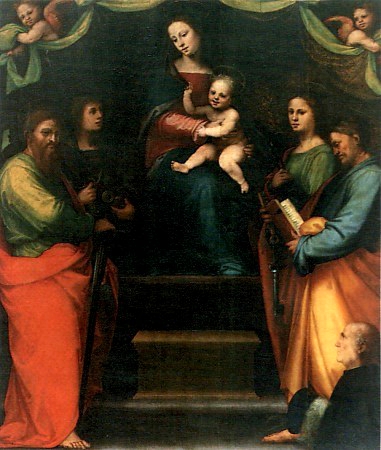Mariotto di Bigio di Bindo Albertinelli (1474 – 1515)
Get a Mariotto Certificate of Authenticity for your painting (COA) for your Mariotto drawing.
For all your Mariotto artworks you need a Certificate of Authenticity (COA) in order to sell, to insure or to donate for a tax deduction.
Getting a Mariotto Certificate of Authenticity (COA) is easy. Just send us photos and dimensions and tell us what you know about the origin or history of your Mariotto painting or drawing.
If you want to sell your Mariotto painting or drawing use our selling services. We offer Mariotto selling help, selling advice, private treaty sales and full brokerage.
We have been authenticating Mariotto and issuing certificates of authenticity since 2002. We are recognized Mariotto experts and Mariotto certified appraisers. We issue COAs and appraisals for all Mariotto artworks.
Our Mariotto paintings and drawings authentications are accepted and respected worldwide.
Each COA is backed by in-depth research and analysis authentication reports.
The Mariotto certificates of authenticity we issue are based on solid, reliable and fully referenced art investigations, authentication research, analytical work and forensic studies.
We are available to examine your Mariotto painting or drawing anywhere in the world.
You will generally receive your certificates of authenticity and authentication report within two weeks. Some complicated cases with difficult to research Mariotto paintings or drawings take longer.
Our clients include Mariotto collectors, investors, tax authorities, insurance adjusters, appraisers, valuers, auctioneers, Federal agencies and many law firms.
We perform Mariotto art authentication, appraisal, certificates of authenticity (COA), analysis, research, scientific tests, full art authentications. We will help you sell your Mariotto or we will sell it for you.

Mariotto was a High Renaissance Italian painter of the Florentine school, closely involved with Fra Bartolomeo and influenced by Raphael.

He was born in Florence.Already as a 12-year old boy, he became a pupil of Cosimo Rosselli, and a fellow-pupil with Fra Bartolomeo with whom he formed such an intimate brotherly rapport that in 1494 the two started their own studio in Florence. Vasari’s opinion was that Mariotto was not so well grounded in drawing as Bartolomeo, and he tells that, to improve his hand he had taken to drawing the antiquities in the Medici garden, where he was encouraged by Madonna Alfonsina, the mother of Duke Lorenzo II de’ Medici. When the Medici were temporarily banished in 1494, he returned to his friend, whose manner he copied so assiduously, according to Vasari, that his works were taken for Baccio’s. When, in the wake of Savonarola’s morality campaign, Baccio joined the Dominican order as Fra Bartolomeo in 1500 and gave up painting, Albertinelli, beside himself with the loss, would have joined him; but, spurred by his success in completing an unfinished Last Judgment of Bartolomeo’s, he resolved to carry on alone. Among his many students was Jacopo da Pontormo and Giuliano Bugiardini.

Mariotto was a most restless person and carnal in the affairs of love and apt to the art of living, and, taking a dislike to the studies and brain-wracking necessary to painting, being also often stung by the tongues of other painters, as is their way, he resolved to give himself to a less laborious and more jovial profession, and so opened the most lovely hostelry outside the Porta San Gallo, and at the sign of the Dragon at the Ponte Vecchio a tavern and inn. This life he led for many months, saying that he had taken up an art that was without muscles, foreshortening or perspective and, better still, without faultfinding, and that the art that he had given up imitated flesh and blood, but this one created flesh and blood; in this if you had good wine you heard yourself praised, but in that every day you were blamed. But at last the low life became an annoyance to him, and, filled with remorse, he returned to painting. ::—Giorgio Vasari, Le Vite de’ più eccelenti architetti, pittori… vol. iv.
Albertinelli’s paintings bear the imprint of Perugino’s sense of volumes in space and perspective, Fra Bartolomeo’s coloring, the landscape portrayal of Flemish masters like Memling, and Leonardo’s sfumato technique. His chief paintings are in Florence, notably his masterpiece, the Visitation (1503) at the Uffizi.

Still wondering about an Italian painting in your family collection? Contact us…it could be by Mariotto.
Reviews
1,217 global ratings
5 Star
4 Star
3 Star
2 Star
1 Star
Your evaluation is very important to us. Thank you.
